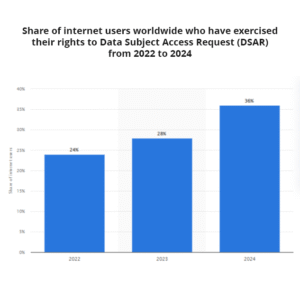- Company
- Solutions
- Industries
Industries We Serve
Get in touch with experts!
Let’s Talk Let’s Talk - Special Links

Every time a law firm is unnerved by rising DSAR volumes, copying and redaction delays, or fears missing a deadline, your team shouldn’t panic; just refine the approach. Outsourcing DSAR review can ease these pressures while you keep the reins firmly in hand. That’s what this playbook covers.
You’ll see exactly how to structure governance, risk, and workflow so you maintain oversight and compliance… while freeing up internal team capacity.
Why law firms need to take control even when outsourcing
Handling a DSAR (Data Subject Access Request) without a tight process can cause delays for busy firms. Internal staffing fluctuates; deadlines risk being missed; manual review becomes costly. Yet, you can’t just hand off responsibility and step back. Here’s how smart firms balance scale, cost, and control.
Real stats that underscore urgency:
-
DSAR requests under CCPA submitted through Termly rose 246% from 2021 to 2024, nearly doubling just from 2023 to 2024 Termly.
-
In 2024, 36% of internet users globally reported exercising their right to DSARs, a rise from 24% in 2022.

(Source: Statista)
Points to note: firms in NZ, AUS, SG, Canada, EU, UK, US all face rising request volume, spurred by GDPR, CCPA/CPRA, PDPA, and local laws. That means more law firm clients ask you to help manage DSAR workflow without exposing them to extra risk.
Playbook: Outsourcing DSAR review without losing control

1. Establish clear handover boundaries
Outsourcing doesn’t mean relinquishing control; it means designing a workflow where execution is delegated, but ownership remains with your firm. Define early which components are retained internally, requester authentication, scoping decisions, exemption rulings, and client-facing communications, and which can be performed externally.
For most firms, that means outsourcing first-level document review, tagging, metadata analysis, and initial redaction suggestions to a trusted partner, while retaining authority over final content and legal strategy. This division not only mitigates risk but also ensures your compliance exposure is actively managed at the right touchpoints.
2. Use dashboards and regular status checkpoints
Transparency in external workflows is essential. Default to secure access to dashboards or shared environments that give the whole team insight into:
- Document review volumes
- Categorization progress
- Outstanding escalations
- Reviewer productivity and timelines
Set a rhythm for team status, including weekly touchpoints or daily updates while working through high volumes, to ensure that you can stay ahead of delays, blockages, or quality issues. When you manage team status calls, make sure all are guided by measurable data and relevant. Without structure, outsourcing becomes ambiguous and reactive. With structure, you create genuine collaborative control.
3. Define quality control via tiered review
A mature DSAR outsourcing model builds in multi-level review layers that clearly separate tasks requiring legal interpretation from operational tagging.
Tier 1 reviewers handle high-volume processing using structured guidelines. They flag complex material exemptions, sensitive categories, and third-party data for second-tier escalation. Your internal team or senior reviewers assess these flagged docs, making final decisions on redactions and disclosure.
This tiered quality model ensures speed and scalability without undermining defensibility. It’s also crucial for firms supporting multinational clients or sector-specific sensitivity (e.g., health, finance, HR).
Also read: The Ultimate Guide to Quality Control in eDiscovery
4. Agree on formal KPIs and SLAs
Don’t outsource without clearly articulated service benchmarks. Your firm should negotiate measurable KPIs within a well-documented SLA framework, including:
- Accuracy thresholds (e.g., <1.5% error rate on PII redactions)
- Escalation SLAs (e.g., all legal queries resolved within 24 hours)
- Turnaround time per batch or per 1,000 documents
- Redaction consistency scores based on sample audit reviews
- Confidentiality protocols and breach reporting timelines
These metrics turn vendor performance into something measurable and actionable so that you can assess not just delivery, but risk containment.
5. Leverage tech to assist and audit
Manual-only workflows are outdated and cost-heavy. Your DSAR review partner should use DSAR software or purpose-built tools to streamline core processes.
This hybrid model technology + human insight reduces variability, improves defensibility, and speeds up turnaround. Make sure you retain access to logs and audit reports as part of your oversight responsibility.
6. Maintain control of exemptions and communications
Exemption decisions, especially around legal privilege, ongoing investigations, or third-party confidentiality, must always sit with your firm. Even in high-volume matters, don’t allow external teams to apply exemptions or draft final responses without internal validation.
Similarly, all client communication cover letters, annexes, and disclosed materials should go out on your firm’s letterhead or platform, with a transparent chain of custody. This maintains your credibility, preserves trust, and aligns with regulatory expectations in jurisdictions like the UK, EU, and California.
7. Review and refine after each job
DSAR workflows improve significantly with post-engagement review loops. Each project should end with a structured debrief:
- Did the provider meet review and turnaround targets?
- Were escalations timely and well-managed?
- Were flagged exemptions correctly surfaced?
- Did you encounter repeatable friction points?
Feed these learnings into a DSAR-specific SOP, adjusting playbooks, intake forms, briefing docs, and QC protocols for the next engagement. Over time, this dramatically reduces coordination overhead—and drives repeatable excellence.
Final words: how Aeren LPO helps firms stay in control
At Aeren LPO, we partner with law firms and legal operations teams, not end clients. Your firm remains in the front seat: you set policies, manage exemptions, and deliver final packages. We supply the trained review teams, project dashboards, quality checks, and tech tool support. You scale without hiring new staff, maintain overs ight, and stay compliant.
This playbook outsourcing dsar review with structure lets you meet deadlines, control risk, cut costs, and satisfy demanding clients across NZ, AUS, SG, the US, UK, Europe and Canada. You remain in charge.


